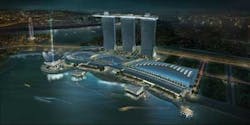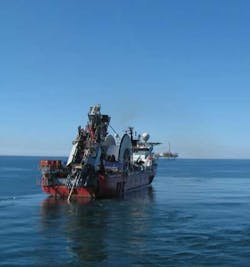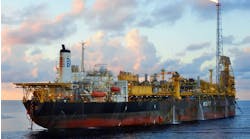Arne B. Olsen, Mads Hjelmeland - Framo Engineering
Seabed boosting is alternative or complementary with other artificial lift techniques and can have advantages in production and field flexibility. Today, helicon-axial pumps have been developed, tested, and installed in numerous subsea field applications and are a proven technology.
Subsea boosting is not just about the pump knowledge, but also about the total system engineering and supply. Understanding the operational process regimes from start-up and continuous flow, through to managing operational upsets such as emergency shutdowns and the process dynamics is key to ensuring a successful system.
The effect of a subsea multiphase booster pump on the oil recovery is significant. The pressure from the well is used to drive the oil to the first stage separator. The resistance is made up of a static and dynamic flow resistance that together represents the system resistance curve.
The well production is found from the intersection of the two curves. Installation of a subsea multiphase booster pump will increase the pressure in the well fluid, i.e. adding kinetic energy directly to the flow. The effect is as if the flowing wellhead pressure is increased. The flow from the wells increases until a new balance between fluid pressure and system resistance is achieved. The effect is a net increase in oil production.
One or several wells in a field eventually may start to show reduction in production pressure. There may be several causes such as drop in the reservoir pressure as the oil is taken out, or increased water production that increases the static and dynamic resistance in the system. Once the first stage separator pressure cannot be met, the operator may have to stop the production from these wells, even if they might produce oil at a lower production pressure for many years.
Tie in of marginal or satellite fields normally involve significant pipeline resistance as tieback distances increase. These applications increase as oil companies seek to increase production. The subsea multiphase pump system is an ideal candidate for satellite field developments, eliminating the need for remote process facilities in marginal fields that otherwise would not justify such investments. By introducing a subsea pump station, production may be boosted to the central processing facility.
The overall cost of installing a subsea pump station relative to an FPSO, or platform is low, and offers benefits in terms of producing challenging fields, with low investment payback time.
Positive choking
Subsea multiphase pumps can increase the pressure from low pressure wells to match high pressure wells. This can be defined as “positive choking,” as the alternative to boosting is choking the strong producers to reduced pressure in the first stage separator. This is relevant in many fields as the oil flow is often commingled in the first stage production facilities. This sometimes creates unbalanced production pressures from the different wells that are tied together.
Helico-axial multiphase pumps can avoid well intervention which usually is required for conventional artificial lift methods such as gas lift and electric submersible pumps (ESPs). By use of multiphase pumps, well intervention may be delayed or postponed until the well is no longer able to flow to surface. The multiphase pumps may be operated in series with alternative artificial lift methods to provide overall lift capabilities and redundancy.
Furthermore, if the multiphase pump has high capacity, one pump may serve several wells.
A high-boost multiphase pump development program was initiated mid-2007, and a fullscale prototype was verified in 2008. The development has been carried out as a Joint Industry Project with Shell, Total, BP, and Statoil as partners, and the test program is currently ongoing. Differential pressure (DP) in excess of 150 bar has been demonstrated for GVFs up to 50% and DP of 100 bar for GVFs up to 80%.
The high-boost pump is based on the same design principle as the conventional helico-axial (Hx) pumps when it comes to hydraulic, mechanical, and electrical components. The upgraded multiphase pump represents a breakthrough for enabling developments with water depths in the range of 2,000 - 3,000 m (6,562 - 9,842 ft).
The combination with a novel thrust balancing technology is the key for this significant boost in performance.
Multiphase pumps normally are installed in dedicated subsea modules designed and customized for the application. Different pump station designs have been installed over the years, and today there is a range of standardized modules. Framo single- and dual-pump stations enable both operation in parallel and/or in series for flexibility in terms of overall turndown and differential pressure capabilities.
The following illustration shows typical process flow schematics of a dual pump station with two flowlines. As can be seen in the schematics, both serial and parallel configurations are possible. The serial configuration will increase the total differential pressure capability of the pump station, whereas the parallel configuration will increase the overall volumetric flow rate capabilities.
The subsea pump module can be designed as an overall production manifold including multiphase metering for continuous well testing and also as a stand-alone booster station. It is common to include a bypass line to allow for natural production if the pump system is down.
It is essential for critical process components to be an integral part of the pump station, clustering all the critical components with regards to the functionality of the subsea pump system. That way, a number of interfaces can be eliminated in a “one-stop shop” concept, also simplifying overall control requirements.
A power and control umbilical is installed between the subsea pump station and the host facility. The umbilical provides high-voltage electric power to the MPP, as well as small power, signals, hydraulic fluids, and chemicals to operate and control the pump station.
Key building blocks
The subsea pump stations, including auxiliary systems, may comprise the following main components and sub-systems:
- Multi-port selector manifold (MSM)
- Multi-phase flow meter (PWVx)
- Sand detector
- Multi-phase pump
- Control system
- Power and control umbilical
- Power and control module.
The Framo MultiManifold, based on MSM, is a compact manifold that combines production and test header into one unit. The MSM in combination with the multiphase meter eliminates a test header and a test line to the production platform, and reduces the size of piping and manifold arrangements. It also reduces the number of isolation valves required.
The MSM is in the center of the manifold, where the purpose is to commingle the incoming flow from the wells into a common production outlet. Integral in the block is the selector arrangement that can take well fluids from one of the incoming wells and direct this flow to the test line with the multi-phase flow meter to measure the individual flow rates of oil, gas, and water. Flow from the meter is re-commingled prior to entering the booster pump export through the transfer line. The MultiManifold is 12.5 m x 7 m x 5.7 m (41 ft x 23 ft x 19 ft), with a total weight of some 85 tons. MultiManifolds are compact and light, and usually reduce the size and weight of a conventional manifold by 65%.
An alternative may be the conventional manifold setup with option of well testing on all the incoming wells.
Development and qualification of the subsea high-boost multiphase pump is a milestone and enables a range of booster technologies.
The pumps are designed to allow operators to change the pump type if large variations in the flow conditions over the field life makes this necessary. This is done by keeping all mechanical and electrical interfaces identical to avoid modifications regardless of pump size and type.
The typical pump system is designed in a standardized modular approach for intervention and connection. Critical components minimize weight but add flexibility, thereby reducing the need for intervention. This is evident in the installation of a subsea pump station from a light intervention vessel, and a pump unit weighing approximately 20 tons and operations with a simple universal running tool.
Condition monitoring, operations support
Subsea multi-phase pumps typically are critical equipment. Accordingly, a high level of operational support and condition monitoring is required to ensure production is maximized, and that the pumps operate within designed limits.
FRIEND (FRamo Interactive ENabling Diagnostics) was developed based on a real-time data monitoring facility with an online support service providing monitoring/diagnostics.
As part of the system, pump(s) performance is condition monitored to capture irregularities or change in performance. The subsea pump usually operates to failure, and eventually is retrieved. Typically, a spare pump is installed within a short time, as the typical pump retrieval time is approximately one day.
Today’s subsea pumps implements the use of fully integrated subsea pump control systems based on large bandwidth electro-hydraulic control systems with fiber optical communication. They also incorporate expandability, both topside and subsea, through industry standard interfaces, and establishe a data highway from topside to subsea.
High boost subsea multiphase pumps are commercially available today, and similar pump units are in operation in numerous field installations worldwide. More than 20 pumps of the Hx-design are in operation worldwide, with a total accumulated run time of more than 900,000 hours.








